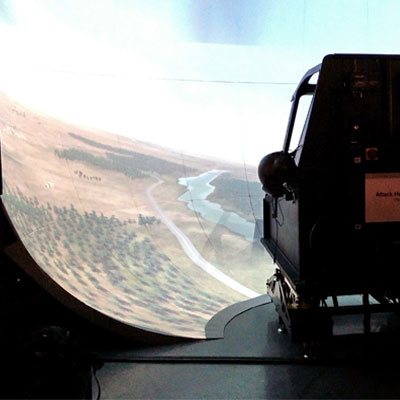Contact Dr Shaun Forth
- Tel: 01234 863291
- Email: s.a.forth@cranfield.ac.uk
- ORCID
Areas of expertise
- Computational Fluid Dynamics
- Computing, Simulation & Modelling
- Explosives and Munitions
- Operational Analysis and Simulation
Background
Shaun Forth started his career as an applied mathematician and was awarded his PhD on analysis of morphological and hydrodynamic instabilities in binary alloy solidification, by Bristol University in 1990.
He then spent five years at BAE Systems' Sowerby Research Centre developing computational fluid dynamics algorithms and software for transonic and supersonic aerodynamics with an emphasis on methods for shocks and adaptive meshing.
In 1994 Shaun joined Cranfield University as lecturer in Applied Mathematics at Shrivenham and was promoted to Senior Lecturer in 2007.
In 2020, Shaun transferred to an Education and Scholarship career pathway.
Research opportunities
After joining Cranfield University, Shaun built up an international reputation in the field of Algorithmic (Automatic) Differentiation (AD). Under EPSRC funding, Shaun and co-workers were the first to implement Griewank and Reese's vertex elimination algorithm for AD using compiler-like source transformation methods, demonstrating how this approach could greatly improve the efficiency of automatically generated code for calculating Jacobians of functions defined by computer code. From 2001, Shaun developed the MAD package for AD of computer programs written in the MATLAB programming language. MAD has featured in many publications and is commercially licensed by the University for distribution by the TOMLAB optimisation software company. Shaun also applied AD techniques to industrial computational fluid dynamics solvers for partners such as: QinetiQ, BAE Systems Ltd, Airbus UK. Shaun was promoted to Senior Lecturer in 2007, largely for his research contributions to AD. Shaun co-edited the Proceedings of the AD2012 International Conference in AD. He co-chaired the AD2016 International Conference on Algorithmic Differentiation at Christ Church, Oxford and guest co-edited an associated special edition of Optimization Methods and Software. He has examined PhD thesis on AD for universities in the UK and Europe.
Between 1998 and 2006 Shaun supported colleagues Dr Peter Smith and Dr Tim Rose to develop the well known blast loading tools Air3D and Air3Dfft that has now been superseded by the commercialised ProSAir package. Shaun has worked with colleagues and insurers Pool Re and Guy Carpenter on developing the UK's first terrorism risk model for the insurance industry. As part of this project, Shaun and colleague Stephanie Burrows modelled the blast loading arising on buildings from truck bombs in central business districts of several cities to assess the maximum likely insurance loss from such an event.
Current activities
Shaun continues to support the ProSAir computational blast loading tool, a Cartesian Mesh CFD solver specialised for assessing blast loads on structures. ProSAir is available for both Commercial and Academic use and is a successor to the Air3D research code.
Shaun leads the Terrorism Risk Assessment, Modelling and Mitigation monthly virtual seminar series. The first virtual seminar was attended by over 60 participants from both universities and the security, engineering and insurance sectors and some 700 researchers, consultants, security service personal are on our mailing list.
Clients
Vardogyir - Terrorism Risk Assessment, Modelling and Mitigation
Insensitive Munitions European Manufacturers' Group (IMEMG) - validation of heating simulation.
Pool Re and Guy Carpenter - developing models for terrorism risk assessment.
Airbus UK and BAE Systems - use of Algorithmic Differentiation to develop an adjoint unstructured finite volume CFD solver.
BAE Systems - CFD tools for blast prediction.
TOMLAB Optimization (USA) - commercialisation of the MAD package for Algorithmic Differentiation in MATLAB.
Publications
Articles In Journals
- Eytan A, Forth SA, Pickering EG, Hazael R & Burrows SJ. (2025). Blast wave ingress into a room through an opening – review of past research and US DoD UFC 3-340-02. International Journal of Protective Structures, 16(3)
- Burrows SJ, Forth SA & Sheldon RP. (2021). Partial validation of CFD blast simulation in a cityscape environment featuring structural failure. International Journal of Computational Methods and Experimental Measurements, 9(4)
- Christianson B, Forth SA & Griewank A. (2018). Preface: Advances in algorithmic differentiation. Optimization Methods and Software, 33(4-6)
- Menshikova M & Forth SA. (2012). Automatic differentiation of quadrature. Optimization Methods and Software, 27(2)
- Forth S, Hovland P, Phipps E, Utke J & Walther A. (2012). Lecture Notes in Computational Science and Engineering: Preface. Lecture Notes in Computational Science and Engineering, 87 LNCSE
- Forth SA. (2006). An Efficient overloaded implementation of forward mode automatic differentiation in MATLAB. ACM Transactions on Mathematical Software, 32(2)
- Forth SA & Ringrose TJ. (2005). Simplifying multivariate second-order response surfaces by fitting constrained models using automatic differentiation.. Technometrics, 47(3)
- Shampine LF, Ketzscher R & Forth SA. (2005). Using AD to solve BVPs in MATLAB. ACM Transactions on Mathematical Software, 31(1)
- Forth SA, Tadjouddine M, Pryce JD & Reid JK. (2004). Jacobian Code Generated by Source Transformation and Vertex Elimination can be as Efficient as Hand-Coding. ACM Transactions on Mathematical Software, 30(3)
- Forth SA & Wheeler AA. (1992). Coupled convective and morphological instability in a simple model of the solidification of a binary alloy, including a shear flow. Journal of Fluid Mechanics, 236(61)
- Forth SA & Wheeler AA. (1989). Hydrodynamic and morphological stability of the unidirectional solidification of a freezing binary alloy: a simple model. Journal of Fluid Mechanics, 202(339)
Conference Papers
- Forth SA, Johnson S, Burrows SJ & Sheldon RP. (2018). Cranfield University centre of excellence in counter-terrorism
- Burrows SJ & Forth SA. (2018). Challenges using ProSAir to simulate blast scenarios in complex cityscapes
- Forth S. (2016). A Matlab implementation of the Minpack-2 Test Problem Collection
- Forth SA & Sharma NK. (2010). A sparse matrix approach to reverse mode automatic differentiation in Matlab
- Tadjouddine M, Forth S & Qin N. (2005). Automatic differentiation of a time-dependent CFD solver for optimisation of a synthetic jet
- Rose TR, Smith PD & Forth S. (2005). Development of an Adaptive Mesh CFD Code for High Explosive Blast Simulation
- Tadjouddine M, Forth SA & Qin N. (2005). Elimination AD applied to Jacobian assembly for an implicit compressible CFD solver
- Forth SA & Ketzscher R. (2004). High-Level Interfaces for the MAD (Matlab Automatic Differentiation) Package.
- Ringrose T & Forth S. (2002). Improved Fitting of Constrained Multivariate Regression Models using Automatic Differentiation
- Forth SA. (2001). A Second Order Accurate, Space-Time Limited, BDF Scheme for the Linear Advection Equation
- Forth S. A Matlab Implementation of the Minpack-2 Test Problem Collection
- Forth S & Kharche RV. Presentation: Performance Improvements and Unit Testing for the MAD Package
Books
- Forth S, Hovland P, Phipps E, Utke J & Walther A (eds). (2012). Recent Advances in Algorithmic Differentiation
- Gupta AK & Forth SA. (2012). An AD-enabled optimization toolbox in LabVIEW(TM) In Forth SA, Hovland P, Phipps E, Utke J & Walther A (eds), Lecture Notes in Computational Science and Engineering (87 LNCSE). Springer Berlin Heidelberg.
- Forth S, Hovland P, Phipps E, Utke J & Walther A (eds). (2012). Recent Advances in Algorithmic Differentiation
- Padulo M, Forth SA & Guenov MD. (2008). Robust aircraft conceptual design using automatic differentiation in Matlab In Bischof CH, Bücker HM, Hovland P, Naumann U & Utke J (eds), Lecture Notes in Computational Science and Engineering (64 LNCSE). Springer Berlin Heidelberg.
- Tadjouddine M, Bodman F, Pryce JD & Forth SA. (2006). Improving the performance of the vertex elimination algorithm for derivative calculation In Buecker , Martin , Corliss G, Naumann U, Hovland P, ... (eds), Lecture Notes in Computational Science and Engineering (50). Springer Berlin Heidelberg.
- Tadjouddine M, Forth SA & Keane AJ. (2006). Adjoint Differentiation of a Structural Dynamics Solver. In Buecker , Martin , Corliss G, Naumann U, Hovland P, ... (eds), Lecture Notes in Computational Science and Engineering (50). Springer Berlin Heidelberg.
- Kharche RV & Forth SA. (2005). Source Transformation for MATLAB Automatic Differentiation. In Alexandronov VN, van Albada GD, Sloot PMA & Dongarra J (eds), Lecture Notes in Computer Science (3994 LNCS - IV). Springer.
- Forth SA & Tadjouddine M. (2003). CFD Newton Solvers with EliAD: An Elimination Automatic Differentiation Tool In Armfield S, Morgan P & Srinvas K (eds), Computational Fluid Dynamics 2002. Springer Berlin Heidelberg.
- Tadjouddine M, Forth SA & Pryce JD. (2003). Hierarchical automatic differentiation by vertex elimination and source transformation In Kumar V, Gavrilova ML, Tan CJK & L'Ecuyer P (eds), Lecture Notes in Computer Science (2668). Springer.
- Forth SA & Evans TP. (2002). Aerofoil Optimisation via AD of a Multigrid Cell-Vertex Euler Flow Solver. In Corliss G, Faure C, Griewank A, Hascoët L, Naumann , ... (eds), Automatic Differentiation of Algorithms. Springer New York.
- Standingford DWF & Forth SA. (2002). A Discrete Sensitivity Solver for an Industrial CFD Code via Automatic Differentiation. In Armfield S, Morgan P & Srinivas K (eds), Computational Fluid Dynamics 2002. Springer Berlin Heidelberg.
- Tadjouddine M, Forth SA, Pryce JD & Reid JK. (2002). Performance Issues for Vertex Elimination Methods in Computing Jacobians using Automatic Differentiation. In Sloot P, Hoekstra A, Tan C & Dongarra J (eds), Lecture Notes in Computer Science (2330 LNCS). Springer.
- Tadjouddine M, Forth SA & Pryce JD. (2002). AD Tools and Prospects for Optimal AD in CFD Flux Jacobian Calculations. WITHDRAWN - duplicate see http://dspace.lib.cranfield.ac.uk/handle/1826/9189 In Corliss G, Faure C, Griewank A, Hascoet L & Naumann U (eds), Automatic Differentiation of Algorithms. Springer New York.
- 551117 - Citation not available


